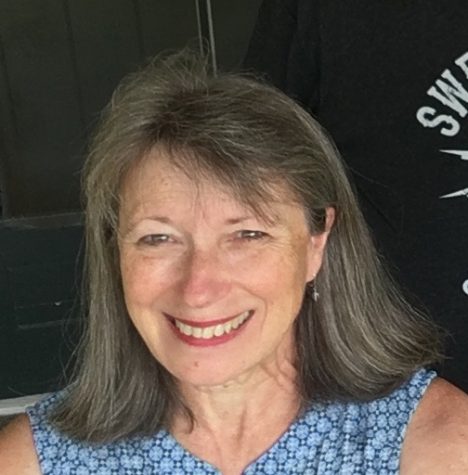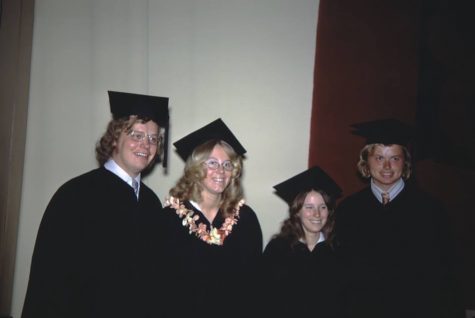Retiring chemistry professor Deberah Simon reflects on science communication, misogyny and contextual chemistry
March 11, 2021

Deberah Simon ‘72, Senior Lecturer of Chemistry, is retiring in August after 26 years at Whitman. A chemist and an artist at her core, she rewrote foundational course-work and furthered connections between disciplines to strengthen students’ grasp of how the world interacts chemically.
Simon developed original General Chemistry labs with her colleague, Machelle Hartman, transforming it from a techniques-based course into one that asks, as she puts it, “How do you need to think about what it is you’re doing, and where it fits into the big picture?”
Simon places the ability to communicate findings with the public at the center of her teaching approach.
“If you can’t tell everyone what you’ve done . . . in a way that’s meaningful to them, then we haven’t done our job,” Simon said.
When Simon attended Whitman in 1968, women had to sit in the front row if they didn’t wear a skirt to class. Dormitories were gender-segregated, and the sciences were entirely male-dominated.
“I’ve been a scientist since I was a little kid,” Simon said. “It never occurred to me that I was a girl and I wasn’t supposed to like that.”
She has multiple family ties to Whitman — in fact, she met her husband on the first day of General Chemistry lab, the class that she now teaches. After she graduated, Simon worked on aluminum production lines at Boeing.

“I was a quality control engineer at 22 years old, in a plant with thousands of men and one other woman as a secretary.”
Simon biked miles through the plant, sampling tanks the size of swimming pools with a fishing hook and little bottles. The harassment started on her first day while she learned her route.
“No one had told me not to wear a skirt . . . women wore dresses to work, end of story. I had to walk on catwalks above all of these tanks and all of these men. I spent the first day grabbing my skirt between my knees,” Simon said. “Their cat calls and the whistles were unbelievable.”
“I know women still are facing challenges,” Simon continued, “but you have to trust me that there are some of us who were out there first, blazing the trails that made a difference.”
Simon’s first day of Chemistry in Art — the course she created for non-science majors at Whitman — was one of her most exciting. Later, art was integrated into the General Chemistry lab. Over the course of a decade, Simon taught 200 chemistry professors in workshops on how to do the same.
“There were a lot of skeptical faculty, even in my own department, because hey, come on, art in chemistry, heaven forbid, that’s artsy stuff,” Simon said. “We just wanted to put chemistry in a context that we knew students could relate to.”
Seeking her out years later at reunions, students still remember concept details they learned through art projects in chemistry lab, like making anodized aluminum keychains.
“[They] pull out their keychain, dangle it in front of me and say, ‘Look! I still remember you talking about the anode,’” Simon said. “And that’s success, if something is embedded in you so that it’s part of you going forward.”
“It gives me chills to think about somebody years later, doing the dishes, maybe telling their kids ‘Hey, this is how the detergent’s working,’” she continued. “It’s not in seeing new things, it’s in seeing with new eyes. I want people to see with new eyes.”
A favorite moment from her time teaching at Whitman, Simon shared, was seeing students “really be themselves” at General Chemistry desserts she threw for 19 years.
“We filled my kitchens with dessert. Professor Hartman would come with the back of her pickup truck literally filled with casserole dishes of pies and cookies. We’d light a fire in the fireplace, and everyone played board games,” Simon said.
In retirement, Simon wants to start a jewelry shop selling decades-worth of Chemistry in Art diffused glass and etched pieces. She’ll spend time with her grandchildren, design knitting patterns, read and garden more — though she said in a cruel turn of fate, eight deer have moved into her yard.
“[They] lounge in my yard and stare at me, so that’s pretty mean,” Simon said, chuckling.





Patty OToole • Mar 14, 2021 at 12:20 pm
Congratulations sweet cousin! You will love retirement! More time to spend doing all the creative things you love to do! You are amazingly talented! Love you ❤️
Richard D. Simon Jr. MD (Class 1972 - chemistry major) • Mar 11, 2021 at 5:12 pm
Deb and I did meet and fall in love at Whitman and we’ve now been married for 47 wonderful years. She is the most wonderful person, the most intelligent person, and the most interesting person I have ever known. She has loved science and art for as long as I have known her. For the 8 and 1/2 years we lived in Chicago in the 1970’s, she did basic science research in cardiology, hepatology, hematology, and immunology at the University of Chicago while at the same time taking numerous classes at the Oriental Institute at the U of C (yes, she reads the inscriptions when we go to ancient museums), all of the classes at the Adler Planetarium, and became a professional calligrapher. She has loved the last 26 years teaching at Whitman and we have both loved the Chemistry desserts – we are both sad that COVID-19 made it impossible to continue that tradition.
We both look forward to the next chapter in our lives. She has spoken often of possibly writing a fictional mystery book set on a campus of a liberal arts college in the New England tradition concerning ………..
Mark Juhasz • Mar 11, 2021 at 1:12 pm
I am so happy to see this story. Deb has been a tremendous contributor to our department, and her teaching has impacted thousands of Whitman students. This is such a well-deserved retirement, but we sure are going to miss Deb!
Jim Ewell • Mar 11, 2021 at 10:47 am
It has been one of life’s privileges sharing a friendship with Deb and Dick over the past 50 years! From our “cell group” meetings while students at Whitman to our most recent visits and communications I have always considered Deb to be one of the most creative and intelligent people I know. Joy and I have friends in Eugene whose son credits Deb, more than any other instructor he had at Whitman, with inspiring his interest in chemistry and medicine. She has obviously touched many lives. Best of luck in your next adventures friend!